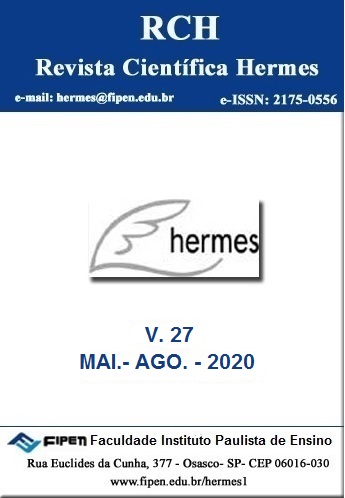The effect of ERP and CRM systems implementation on customer satisfaction
DOI:
https://doi.org/10.21710/rch.v27i0.540Keywords:
Productive Systems, Enterprise Resource Planning, Customer Relationship Management, Customer Satisfaction.Abstract
This study aims to analyze the effect of ERP and CRM systems on customer satisfaction. More specifically, evaluate the correlation between the ERP and CRM systems implementation and the customer satisfaction indicators, such as completed and on-time orders, by comparing data before and after systems implementation. For this, the field research method was used through the quantitative analysis of primary data, obtained from a multinational company in the scientific and health equipment sector, selected non-probabilistically, but the selection met the condition of the company. have a mature customer satisfaction assessment process using indicators based on a survey sent to each sales order shipped. The survey results indicated that the survey of 16 questions with 759 respondents, performed by the company, presented optimal internal consistency, measured by Cronbach's alpha coefficient. However, although the response averages tended to improve after the implementation of the ERP and CRM systems, from a statistical point of view, such improvement cannot be considered significant, since the averages are within the same range. confidence. It is recommended to develop a new line of investigation including the behavioral evaluation of other operational and financial variables, such as inventory turnover, sales revenue and profitability, also considering the lag effect evaluation after the ERP and CRM systems implementation.References
Ata, Z. U., & Toker, A. (2012). The effect of customer relationship management adoptionin business-to-business markets. Journal of Business and Industrial Marketing.
Beheshti, H. M., & Beheshti C. M. (2010) Improving productivity and firm performance withenterprise resource planning. Enterprise Information Systems.
Bland, J. M.,& Altman, D. G. (1997). Cronbach’s Alpha. Statistics Notes. BMJ, v. 314.
Bryman, A. (2012). Social Research Methods. 4th ed. New York: Oxford University Press Inc.
Buttle, F., & Maklan, S. (2015). Customer Relationship Management. Concepts and technologies. 3rd ed. Routledge.
Creswell, J. W. (2014). Research Design: Qualitative, Quantitative, and Mixed Methods Approaches. 4th ed. Thousand Oaks, CA: Sage Publications, Inc.
Cortina, J. M. (1993). What is Coefficient Alpha? An Examination of Theory and Applications. Journal of Applied Psychology, 78 (1), 98-104.
Cronbach, L. J. (1951). Coefficient Alpha and the Internal Structure of Tests. Psychometrika, 16(3).
Field, A. (2009). Discovering Statistics using SPSS (3rded.). Sage.
Giglio, C. R. F. S. (2018). A Influência do Teletrabalho no Desenvolvimento de Software. Dissertação de Mestrado – Centro Paula Souza.
Gil, A. C. (2008) Métodos e Técnicas de Pesquisa Social (6ª ed.). São Paulo: Editora Atlas.
Hendricks, K. B., Singhal, V. R., & Stratman, J. K. (2006). The impact of enterprise systems on corporate performance: A study of ERP, SCM, and CRM system implementations. Journal of Operations Management, ScienceDirect, 25, 65-82.
Herkenhoff, L., & Fogli, J. (2013). Applied Statistics for Business and Management using Microsoft Excel. Springer.
Kumar, V., & Reinartz, W. (2018). Customer Relationship Management. Concept, Strategy, and Tools (3rd ed.). Springer.
Leontitsis, A., & Pagge, J. (2007). A simulation approach on Cronbach’s alpha statistical significance. Mathematics and Computers in Simulation. v. 73, p. 336-340.
Landis, J. R., & Koch, G. G. (1977). The Measurement of Observer Agreement for Categorical Data. Biometrics, 33, 159-174.
Larson, R., & Farber, B. (2010). Estatística Aplicada (4ª. ed.). Pearson.
Marconi, M. A., & Lakatos, E. M. (2003). Fundamentos da Metodologia Científica (5ª ed.) São Paulo: Editora Atlas.
Mithas S., Krishnan, M.S., & Fornell C. (2005). Why Do Customer Relationship Management Applications Affect Customer Satisfaction? Journal of Marketing, 69,201-209.
Monk, E. F., & Wagner, G. J. (2013). Concepts in Enterprise Resource Planning (4th ed.). Cengage Learning.
O’brien, J. A., & Marakas, G. M. (2018). Management Information Systems (10th ed.). McGraw-Hill, 2011. SCOPUS – ELSEVIER Disponível em . Acesso em 17 Nov.
Tate, R. F. (1954). Correlation Between a Discrete and a Continuous Variable. Point-Biserial Correlation. The Annals of the Mathematical Statistics, 25(3), 603-607.
Tseng, S., & Wu, P. (2014). The impact of customer knowledge and customer relationship management on service quality. International Journal of Quality and Service Sciences.
Umble, E. J., Haft, R. R., & Umble, M. M. (2003). Enterprise resource planning: Implementation proceduresand critical success factors. European Journal of Operational Research, 146, 241-257.
Downloads
Published
How to Cite
Issue
Section
License
Copyright (c) 2020 Revista CientÃfica Hermes - FIPEN

This work is licensed under a Creative Commons Attribution 4.0 International License.






